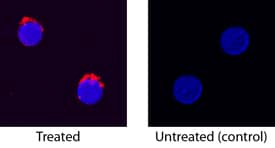Canine IL-6 Biotinylated Antibody
R&D Systems, part of Bio-Techne | Catalog # BAF1609


Key Product Details
Validated by
Species Reactivity
Validated:
Cited:
Applications
Validated:
Cited:
Label
Antibody Source
Product Specifications
Immunogen
Thr23-Met207
Accession # P41323
Specificity
Clonality
Host
Isotype
Scientific Data Images for Canine IL-6 Biotinylated Antibody
IL‑6 in Canine PBMCs.
IL-6 was detected in immersion fixed canine peripheral blood mononuclear cells (PBMCs) treated with Concanavalin A using Goat Anti-Canine IL-6 Biotinylated Antigen Affinity-purified Polyclonal Antibody (Catalog # BAF1609) at 15 µg/mL for 3 hours at room temperature. Cells were stained using the NorthernLights™ 557-conjugated Streptavidin (red; Catalog # NL999) and counterstained with DAPI (blue). Specific staining was localized to cytoplasm. View our protocol for Fluorescent ICC Staining of Non-adherent Cells.Applications for Canine IL-6 Biotinylated Antibody
Immunocytochemistry
Sample: Immersion fixed canine peripheral blood mononuclear cells treated with Concanavalin A
Western Blot
Sample: Recombinant Canine IL-6 (Catalog # 1609-CL)
Canine IL-6 Sandwich Immunoassay
Formulation, Preparation, and Storage
Purification
Reconstitution
Formulation
Shipping
Stability & Storage
- 12 months from date of receipt, -20 to -70 °C as supplied.
- 1 month, 2 to 8 °C under sterile conditions after reconstitution.
- 6 months, -20 to -70 °C under sterile conditions after reconstitution.
Background: IL-6
Interleukin 6 (IL-6) is a pleiotropic alpha-helical cytokine that plays important roles in acute phase reactions, inflammation, hematopoiesis, bone metabolism, and cancer progression. IL-6 activity is central to the transition from acute inflammation to either acquired immunity or chronic inflammatory disease. It is secreted by multiple cell types as a 22-28 kDa phosphorylated and variably glycosylated molecule (1-4). Mature canine IL-6 is 187 amino acids (aa) in length and shares 76%, 59%, 38%, and 40% aa sequence identity with feline, human, mouse, and rat IL-6, respectively (5). IL-6 induces signaling through a cell surface heterodimeric receptor complex composed of a ligand binding subunit (IL-6 R) and a signal transducing subunit (gp130). IL-6 binds to IL-6 R, triggering IL-6 R association with gp130 and gp130 dimerization (6). gp130 is also a component of the receptors for CLC, CNTF, CT-1, IL-11, IL-27, LIF, and OSM (7). Soluble forms of IL-6 R are generated by both alternate splicing and proteolytic cleavage (3). In a mechanism known as trans-signaling, complexes of soluble IL-6 and IL-6 R elicit responses from gp130-expressing cells that lack cell surface IL-6 R (3). Trans-signaling enables a wider range of cell types to respond to IL-6, as the expression of gp130 is ubiquitous while that of IL-6 R is predominantly restricted to hepatocytes, leukocytes, and lymphocytes (3). Soluble splice forms of gp130 block trans-signaling from IL-6/IL-6 R but not from other cytokines that utilize gp130 as a coreceptor (4, 8).
References
- Van Snick, J. (1990) Annu. Rev. Immunol. 8:253.
- Hodge, D.R. et al. (2005) Eur. J. Cancer 41:2502.
- Jones, S.A. (2005) J. Immunol. 175:3468.
- Rose-John, S. et al. (2006) J. Leukoc. Biol. 80:227.
- Kukielka, G.L. et al. (1995) Circulation 92:1866.
- Murakami, M. et al. (1993) Science 260:1808.
- Muller-Newen, G. (2003) Sci. STKE 2003:PE40.
- Mitsuyama, K. et al. (2006) Clin. Exp. Immunol. 143:125.
Long Name
Alternate Names
Entrez Gene IDs
Gene Symbol
UniProt
Additional IL-6 Products
Product Documents for Canine IL-6 Biotinylated Antibody
Product Specific Notices for Canine IL-6 Biotinylated Antibody
For research use only